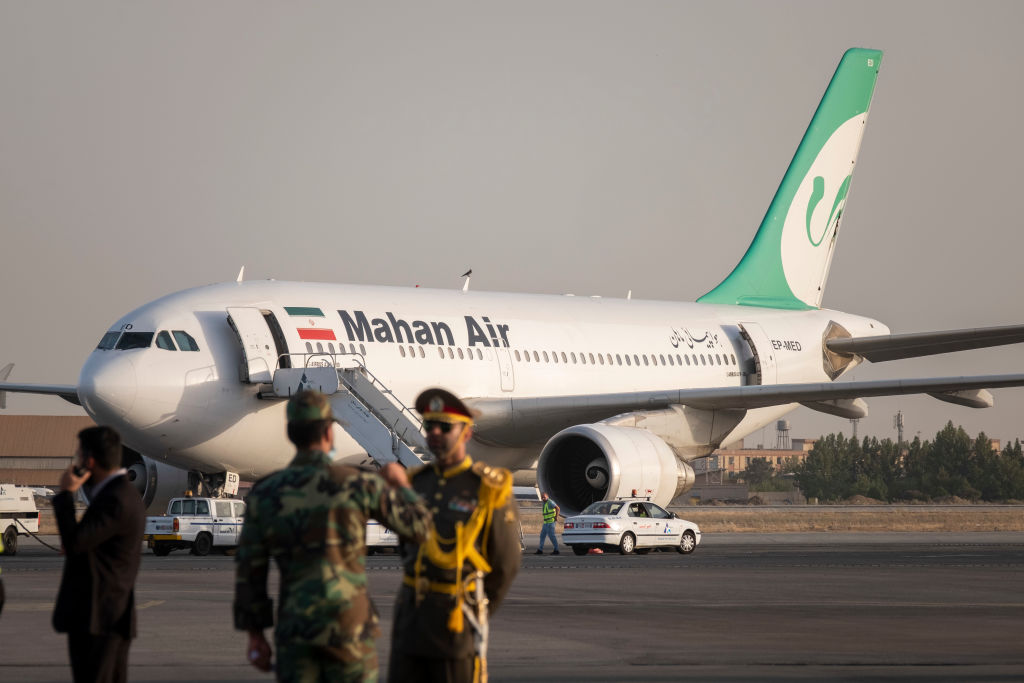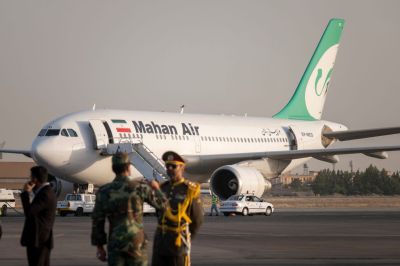The Islamic Republic of Iran’s civil aviation sector has played a vital role in the regime’s support of terror, repressive dictators, and military aggression around the world. It provides logistical support in multiple theaters of war, ferrying militias for Syria’s Assad regime, delivering weapons systems to Hezbollah through Damascus and Beirut, dispatching drones to war-torn Ethiopia, and replenishing Russia’s depleted arsenal since its invasion of Ukraine.
Denying Iran access to new aircraft, seizing existing ones, and disrupting procurement attempts should be a top priority for the Biden administration.
To be sure, U.S. sanctions have successfully limited Iranian access to modern aircraft and the parts and services to keep them running for decades. Its aviation fleet is old and has declined in quantity and quality over time. But a more robust and creative enforcement of sanctions could further curtail Iran’s occasionally successful efforts to evade enforcement.
Indeed, Iran has long engaged sanctions enforcers in a complex and evolving cat-and-mouse game. Displaying ingenuity and inventiveness, Iran has defied bans and bypassed financial restrictions to keep its fleet from being grounded.
As recently as December, Iran procured four wide-bodied Airbus A340 aircraft through a complex series of actions designed to obscure their ultimate destination. Previously owned by Turkish Airlines, the aircraft were sold to a Hong Kong-based company that registered them in the Channel Island of Guernsey and then stored them in South Africa in 2019. When they departed Johannesburg last month, the four planes bore a new registration, from the African nation of Burkina Faso, whose national airline has only a small fleet of four Embraer jets—which accommodate from 70 to 112 passengers—and thus was an unlikely recipient of the much-larger A340s. Rather than flying to Ouagadougou, the four long-haul passenger planes headed to Uzbekistan and eventually landed in Tehran. Local aviation authorities have since confirmed the four planes are joining Iran’s civil aviation fleet.
The downside for Iran is that these planes are all more than 20 years old. One of them is so accident-prone that it earned the nickname of “Crazy Mike” from its former operating crew in Turkey because of its frequent technical failures. So even when sanctions fail, Iran can rarely get its hands on anything other than old, second-hand planes. Old planes need parts and maintenance. Those, too, are hard to come by because of sanctions. Some planes end up being unusable and are cannibalized for spare parts. And there is always the risk that U.S. authorities will act against intermediaries, making the next procurement effort more complicated and costly.
In 2007, for example, Iran’s largest private commercial carrier, Mahan Air, relied on an Armenian intermediary to buy several old Boeing 747s. U.S. authorities tracked the acquisition of the 747s and in 2008 located three of the aircraft in South Korea, where they were being refurbished. Legal action against the original owner of the aircraft ended in a costly fine in 2010 for the British-based supplier.
By contrast, after Fars Air Qeshm, a cargo carrier linked to Iran’s Islamic Revolutionary Guards Corps, obtained two old Boeing cargo aircraft in 2015, again through an Armenian cutout, the airline was not sanctioned until 2019. Both planes are now more than 30 years old and beset by technical problems that have grounded them repeatedly, yet they nevertheless provided yeoman service for the Islamic regime. The two aircraft were used extensively by Iran to airlift weapons and personnel to Syria during its civil war. More recently, one of them flew to Moscow multiple times in the early stages of Russia’s invasion of Ukraine.
But not every aircraft Iran secures is old. In 2015, Mahan Air set up a scheme involving an Iraqi intermediary to procure nine Airbus aircraft formerly operated by Virgin Atlantic (this while Iran’s negotiators were applying the final touches to the Iran nuclear deal in Vienna, alongside U.S. negotiators). These planes were all in relatively new and good condition: One was 11 years old, another 12, five were 13 years old, and one was 18. Only one was more than 20. The acquisition of relatively new aircraft for long-haul routes temporarily allowed Mahan Air to expand and better service its destinations. Yet, U.S. sanctions merely two weeks after their delivery and subsequent U.S. diplomatic pressure led to the closure of Mahan’s European destinations, limiting their usefulness.
Over time, Mahan Air’s Airbus 340 fleet has begun to suffer from the same parts and maintenance problems afflicting Iranian airliners across the board. That may be the reason Iran eventually transferred four A340s to Venezuela’s Conviasa and to Syrian Arab Air: Its allies are even more starved for planes by U.S. sanctions, and they depend on Iran to successfully circumvent them. Removing old planes from its fleet to sell them to another rogue regime may bring in hard currency and buy political capital with allies. But moving aging planes from one bad actor to another does not multiply them or keep them airworthy.
The uphill struggle Iran’s civil aviation continues to confront because of sanctions is in plain sight, even on the odd day when Iran’s procurement efforts score a success.
Why then should the United States increase pressure, given that existing sanctions have forced Iran to pay huge premiums to fly a decrepit fleet it can barely maintain? The answer is that Iran’s aircraft, creaky though they may be, are still making a difference when it comes to fueling conflict. Without Iran’s airlift to Syria, it is doubtful Bashar al-Assad would still rule his country. Without ongoing flights to Damascus and Beirut, Hezbollah would have a much harder time accessing cutting-edge technology for the advanced weapons program it is developing to fuel its next war against Israel. Without Iranian cargo, Moscow would not be able to replenish its depleted arsenal so quickly.
The recent seizure of a Venezuelan cargo plane formerly owned by Iran’s Mahan Air provides clues about actions U.S. authorities should contemplate to further disrupt the mischief Iran’s fleet routinely carries out.
Mahan sold the aircraft, a 36-year-old Boeing 747, to Conviasa’s cargo subsidiary, Emtrasur, after the aircraft was initially retired in 2019 and cannibalized to service another 747. The operation involved removing two engines from the aircraft. Nevertheless, Mahan was eventually able to replace the missing engines and deliver an operating aircraft to its client. The newly painted cargo jet began operations in February 2022, but during an early-June trip to Buenos Aires, local fuel suppliers caught wind that the aircraft was under U.S. sanctions and refused to supply it for the journey back. The crew was detained and a subsequent U.S. Department of Justice forfeiture action grounded the aircraft indefinitely: It is still in Buenos Aires.
Seizing sanctioned Iranian planes is not something the U.S. can do everywhere. When Mahan or Fars Air Qeshm ferry deadly cargo between Tehran and Damascus or to Moscow, there is little the U.S. can do. But these same planes fly to multiple destinations. Fars Air Qeshm’s aircraft has flown to Venezuela multiple times, making stopovers in numerous African countries and, more than once, in Belgrade, Serbia. The same plane frequently flies to India and Pakistan. Mahan Air continues service to the United Arab Emirates, Thailand, and Turkey. Seizing planes through Justice Department action is possible and—in the age of commercially available, internet-accessible flight trackers—it should not take enormous resources to determine when an aircraft is scheduled to land at vulnerable destinations.
The seizure of aircraft is a powerful tool that can provide a veritable gold mine of information about Iran’s procurement channels. Take, again, the Boeing 747 that Mahan transferred to Emtrasur. At some point before the transfer Mahan was able to procure replacement engines. By gaining access to a sanctioned Iranian plane, U.S. authorities can determine the origin of those engines and the many spare parts that were added over the years. It can identify the companies that sold those parts to Iran, map Iran’s supply chain, and go after Iran’s middlemen. It is an indictment bonanza waiting to happen, and would have dramatic ripple effects through the universe of intermediaries Iran uses to evade sanctions. Further cutting Iran’s supply lines would squeeze its aging fleet even more and diminish its ability to serve Iran’s nefarious goals.
Iran’s successes at evading sanctions in the aviation sector are, in short, ephemeral. U.S. countermeasures have severely constrained Iran’s room for maneuver. And yet that room is sufficient to still deliver Iran’s deadly cargo around the world. If the objective of sanctions is to neutralize those efforts, then the Biden administration can and should do more to make Iran’s occasional procurement stunt a fool’s errand.






Please note that we at The Dispatch hold ourselves, our work, and our commenters to a higher standard than other places on the internet. We welcome comments that foster genuine debate or discussion—including comments critical of us or our work—but responses that include ad hominem attacks on fellow Dispatch members or are intended to stoke fear and anger may be moderated.
With your membership, you only have the ability to comment on The Morning Dispatch articles. Consider upgrading to join the conversation everywhere.